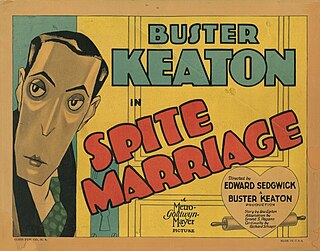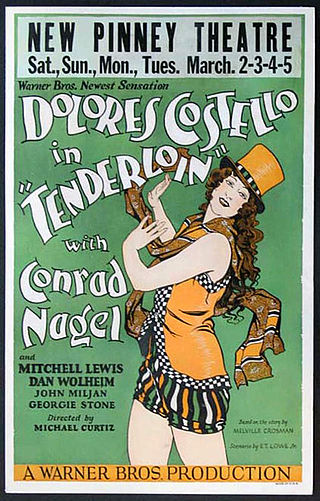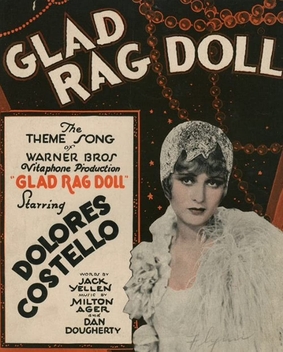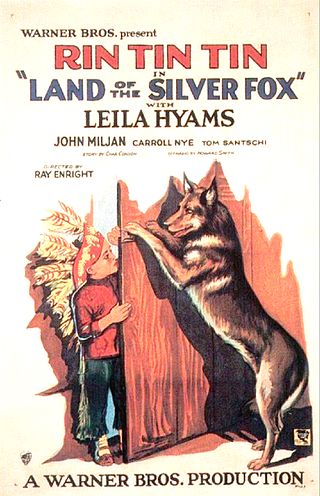
Vitaphone was a sound film system used for feature films and nearly 1,000 short subjects made by Warner Bros. and its sister studio First National from 1926 to 1931. Vitaphone is the last major analog sound-on-disc system and the only one that was widely used and commercially successful. The soundtrack is not printed on the film, but issued separately on phonograph records. The discs, recorded at 33+1⁄3 rpm and typically 16 inches (41 cm) in diameter, are played on a turntable physically coupled to the projector motor while the film is projected. Its frequency response is 4300 Hz. Many early talkies, such as The Jazz Singer (1927), used the Vitaphone system. The name "Vitaphone" derived from the Latin and Greek words, respectively, for "living" and "sound".

Charles William Haines was an American actor and interior designer.

Leila Hyams was an American actress who came from a show business family. Her relatively short film career began in 1924 during the era of silent films and ended in 1936. The blonde blue-eyed ingenue and leading lady appeared in more than 50 film roles and remained a press favourite, with numerous magazine covers.

Don Juan is a 1926 synchronized sound American romantic adventure film directed by Alan Crosland. It is the first feature-length film to utilize the Vitaphone sound-on-disc sound system with a synchronized musical score and sound effects, though it has no spoken dialogue. The film is inspired by Lord Byron's 1821 epic poem of the same name. The screenplay was written by Bess Meredyth with intertitles by Maude Fulton and Walter Anthony.
Phonofilm is an optical sound-on-film system developed by inventors Lee de Forest and Theodore Case in the early 1920s.

Spite Marriage is a 1929 American synchronized sound comedy film co-directed by Buster Keaton and Edward Sedgwick and starring Keaton and Dorothy Sebastian. While the film has no audible dialog, it was released with a synchronized musical score with sound effects using both the sound-on-disc and sound-on-film process. It is the second film Keaton made for MGM and his last film without audible dialogue, although he had wanted it to be a "talkie" or full sound film. Keaton later wrote gags for some up-and-coming MGM stars like Red Skelton, and from this film recycled many gags, some shot-for-shot, for Skelton's 1943 film I Dood It.

General Crack is a 1929 American pre-Code sound all-talking historical costume melodrama with Technicolor sequences which was directed by Alan Crosland and produced and distributed by Warner Bros. It was filmed and premiered in 1929, and released early in 1930. It stars John Barrymore in his first full-length talking feature. The film would prove to be Crosland and Barrymore's last historical epic together. It was based on the 1928 novel General Crack by the British writer Marjorie Bowen, published under the name George Preedy, one of her several pen names.

"A Retrieved Reformation" is a short story by American author O. Henry first published in The Cosmopolitan Magazine, April 1903. The original title was "A Retrieved Reform". It was illustrated by A.I. Keller.

Tenderloin is a 1928 American sound part-talkie crime film directed by Michael Curtiz and starring Dolores Costello. In addition to sequences with audible dialogue or talking sequences, the film features a synchronized musical score and sound effects along with English intertitles. The soundtrack was recorded using the Vitaphone sound-on-disc system. It was produced and released by Warner Bros. Tenderloin is considered a lost film, with no prints currently known to exist.

Glad Rag Doll is a 1929 American sound part-talkie pre-Code drama film directed by Michael Curtiz and starring Dolores Costello, Ralph Graves and Audrey Ferris. In addition to sequences with audible dialogue or talking sequences, the film features a synchronized musical score and sound effects along with English intertitles. The soundtrack was recorded using the Vitaphone sound-on-disc system. This is one of many lost films of the 1920s, no prints or Vitaphone discs survive, but the trailer survives. The film's working title was Alimony Annie, but was changed match the title of the theme song. The theme song is entilted Glad Rag Doll both played and sung throughout the soundtrack.

Hardboiled Rose is a 1929 American sound part-talkie romantic drama film directed by F. Harmon Weight and released by Warner Bros. In addition to sequences with audible dialogue or talking sequences, the film features a synchronized musical score and sound effects along with English intertitles. The soundtrack was recorded using the Vitaphone sound-on-disc system. The film starred Myrna Loy, William Collier, Jr., and John Miljan.

The Lion and the Mouse (1928) is a sound part-talkie drama film produced by Warner Bros., directed by Lloyd Bacon, and based on the 1905 play by Charles Klein. In addition to sequences with audible dialogue or talking sequences, the film features a synchronized musical score and sound effects along with English intertitles. The soundtrack was recorded using the Vitaphone sound-on-disc system. The film marks the first time Lionel Barrymore, who was on loan out from MGM, spoke from the screen.

Alias Jimmy Valentine is a 1920 American silent crime drama film starring Bert Lytell, directed by Edmund Mortimer and Arthur Ripley, and released through Metro Pictures.

State Street Sadie is a 1928 American sound part-talkie crime drama film directed by Archie Mayo. In addition to sequences with audible dialogue or talking sequences, the film features a synchronized musical score and sound effects along with English intertitles. The soundtrack was recorded using the Vitaphone sound-on-disc system. This is regarded as a lost film.
The River Woman is a 1928 American sound part-talkie drama film directed by Joseph Henabery. In addition to sequences with audible dialogue or talking sequences, the film features a synchronized musical score and sound effects along with English intertitles. The soundtrack was recorded using a sound-on-disc system. Made by an independent company, Gotham, the film starred Lionel Barrymore and Jacqueline Logan.

Beware of Bachelors is a 1928 American part-talkie pre-code comedy drama film produced and released by Warner Bros., and directed by Roy Del Ruth. In addition to sequences with audible dialogue or talking sequences, the film features a synchronized musical score and sound effects along with English intertitles. The soundtrack was recorded using the Vitaphone sound-on-disc system. The movie stars Audrey Ferris, William Collier Jr., Margaret Livingston, Clyde Cook, and George Beranger. The film was based on a short story by Mark Canfield.
The Greyhound Limited is 1929 part-talkie talkie crime drama and railroad theme film directed by Howard Bretherton and starring Monte Blue. In addition to sequences with audible dialogue or talking sequences, the film features a synchronized musical score and sound effects along with English intertitles. The soundtrack was recorded using the Vitaphone sound-on-disc system. The film was produced and distributed by Warner Bros.. The film is a follow-up to the 1927 film The Black Diamond Express.

Land of the Silver Fox is a 1928 sound part-talkie American adventure film directed by Ray Enright and written by Howard Smith and Joseph Jackson. In addition to sequences with audible dialogue or talking sequences, the film features a synchronized musical score and sound effects along with English intertitles. The soundtrack was recorded using the Vitaphone sound-on-disc system. The film stars Rin Tin Tin, Leila Hyams, John Miljan, Carroll Nye, Tom Santschi, and Neola May. The film was released by Warner Bros. on October 18, 1928.

The Girl in the Glass Cage is a 1929 American sound part-talkie crime drama film directed by Ralph Dawson and starring Loretta Young, Carroll Nye, Matthew Betz, Lucien Littlefield, and Ralph Lewis. In addition to sequences with audible dialogue or talking sequences, the film features a synchronized musical score and sound effects along with English intertitles. The soundtrack was recorded using the Vitaphone sound-on-disc system. It is based on the 1927 novel of the same name by George Kibbe Turner. The film was released by Warner Bros. on June 23, 1929.
















